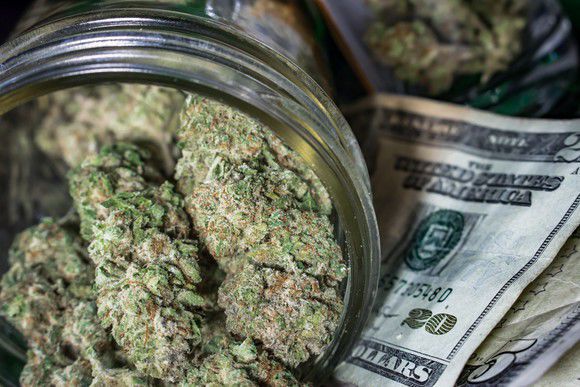In case you haven’t been paying attention, the buzz on Wall Street has been all about marijuana stocks in recent years. According to ArcView, a leading cannabis research firm, the North American legal weed market is on track to grow by 26% annually through 2021. If this estimate proves accurate, the North American legal pot market would be generating almost $22 billion in sales by 2021, which is roughly triple what it generated in 2016. That’s the type of growth that green rush investors simply can’t overlook.
Over the trailing year, pot stock investors have been treated to huge gains. Many of the largest marijuana growers, and even cannabinoid-based drug developers, have seen their market caps double or triple in value. The reason? The aforementioned double-digit, or even triple-digit, sales growth is one answer, along with a steady shift in the way the public views cannabis. Gallup’s October 2017 survey showed that nearly two out of three Americans now favor the idea of legalizing marijuana nationally, up from just 25% who felt that way back in 1995.
News flash: Profits matter
But as some of us learned the hard way during the dot-com boom and bust, operating a business is about more than just revenue growth. Bottom-line fundamentals matter; and if these marijuana stocks want to hang on to their lofty valuations, they’re going to need to generate profits. Looking at the current year, just three marijuana stocks are projected to be in the black.
Why so few profitable marijuana stocks? To begin with, marijuana is still illegal for recreational consumption in all countries around the world, save for Uruguay, making it difficult for cannabis companies to generate enough in sales to be consistently profitable. The other issue is that in areas where medicinal cannabis has been legalized, or recreational marijuana is being considered for legalization, as in Canada, growers are spending money at a feverish pace to expand their growing capacity. This spending, along with possible acquisition costs, is ultimately pushing most of these companies into the red.
If you’re looking for profitable pot stocks in 2018, according to Wall Street’s current (but always fluid) consensus, you should probably focus on the following three companies.
1. Aphria
Among pure-play marijuana stocks, none stands to put more profits in its coffers in 2018 than Canadian-based grower Aphria (NASDAQOTH:APHQF). This shouldn’t come as a big surprise as its management team has been more committed to staying in the black as it expands than any of its peers. In fact, Aphria has reported two consecutive full-year profits. Even though its earnings per share has been marginal relative to its valuation, it’s nonetheless a step ahead of its competition in this department.
Aphria’s secret sauce to success has primarily been its focus on organic growth, although it did recently become active as an acquirer and partner. Its main project is its more than $100 million four-phase capacity expansion that’s expected to boost production to around 100,000 kilograms annually over 1 million square feet. This project is slated for completion in late January 2019.
More recently, it announced a strategic partnership with Double Diamond Farms that’s designed to bring in 120,000 kilograms of annual production by January 2019. Despite previously going the organic route, the buildout of Aphria’s own 100-acre site wouldn’t have been completed till 2020. In forming this strategic partnership, Aphria more than doubles its production and knocks a year off its timeline to do so. To boot, it also recently announced the acquisition of Broken Coast Cannabis, which is expected to add another 10,500 kilograms of annual production to its portfolio.
Aphria has also been a master at networking. It’s one of a handful of Canadian growers with the green light to export dried cannabis to foreign countries that have legalized medical weed. It also recently partnered with Shoppers Drug Mart, which is part of the Loblow Companies, in Canada to provide online medical marijuana. Shoppers Drug Mart has 1,300 locations throughout Canada, so this licensing agreement should mean a major uptick in exposure.
2. Scotts Miracle-Gro
Among marijuana stocks, but non-pure plays, no company will generate more in the way of profits than Scotts Miracle-Gro (NYSE:SMG). That’s because 89% of sales for Scotts Miracle-Gro in 2017 were derived from its core lawn and garden business. Sure, this business can be impacted by weather conditions and consumers’ discretionary spending habits, but it’s generally very predictable. This means that if the cannabis industry were to suffer major legal blows in the U.S. or abroad, Scotts could still fall back on its steady core business.
Nevertheless, sales for the company’s subsidiary, Hawthorne Gardening Co., soared in 2017. Hawthorne has primarily grown by acquisition, and focuses on hydroponics (growing plants in a nutrient-rich water solvent solution), soil, nutrient, and lighting solutions for the medical cannabis industry. Now accounting for 11% of total sales, Hawthorne generated $287.2 million, a 137% year-on-year increase. In terms of organic growth (i.e., without factoring in acquisitions), sales still grew by a healthy 20%, topping the company’s internal expectations.
Some on Wall Street have expressed concern for the U.S. medical pot business after Attorney General Jeff Sessions announced the rescinding of the Cole memo. The Cole memo was a loose set of “rules” that legalized states agreed to abide by in order to keep the federal government off their backs. Examples included keeping grown marijuana within the state and ensuring that pot didn’t fall into the hands of adolescents. Rescinding the Cole memo gives state prosecutors the discretion to go after marijuana violations, even in legal states. The good news, though, is that Scotts is a global brand, and it can easily shake off these concerns by focusing on Canadian, Mexican, or European customers.
Barring terrible weather patterns in the U.S., Scotts Miracle-Gro should be on track for a solidly profitable year.
3. OrganiGram Holdings
Lastly, OrganiGram Holdings (NASDAQOTH:OGRMF) is expected to just squeak out a profit, though it may not even earn a full penny per share when all is said and done, according to Wall Street’s consensus.
Like Aphria, OrganiGram’s success — and by success, I mean its ability to potentially turn a profit — is derived from its focus on organic expansion. OrganiGram operates just a single grow location at Moncton, New Brunswick, and is planning to more than double its current square footage to 429,000 and more than triple its annual production from 20,000 kilograms to 65,000 kilograms. The advantage of operating a single grow location can be found in its expenditures, which will be considerably lower than most of its peers.
OrganiGram is also set up for success if Canada moves forward with legalizing recreational weed by July 2018. It’s been given the OK by the New Brunswick provincial authority to supply a minimum of 5 million grams of dried cannabis a year to cover recreational marijuana demand. This is believed to have an estimated sales value of between $31 million and $47 million a year.
OrganiGram’s product portfolio expansion is another factor pushing it toward profitability. Whereas most growers are focused on dried cannabis production, and with good reason since it’s the most demanded type of cannabis, OrganiGram has branched off to cannabis extracts and oils. These are considerably higher-priced and higher-margin products that could be the difference in pushing OrganiGram into the black in 2018.
credit:fool.com







